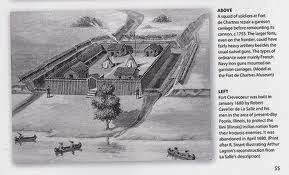The French had many forts in North
America. They were mostly established
and destroyed in the 1600s and the 1700s. Some were permanent and some went
on to cities we have today. Let’s look at 3 forts of the French men.
____________________________________________________
Fort Crevecoeur
On January 5th, 1680, the French explorers: La Salle and Henri
De Tonti established Fort Crevecoeur, but it didn’t last long
In April 15th, 1680, Tonti left Crevecoeur to begin a new settlement
and left seven people at the fort. The next day the seven men took everything
from the fort, blew it up, and fled back to Canada.
____________________________________________________
Fort Detroit
This fort was built in 1701
by Officer Antoine de la Mothe Cadillac. At present day it is in Detroit,
Michigan.
It was built to keep the English from moving
west and to make more fur trade in America.
On
November 9th, 1760 the fort was conquered by the British, but in
1796, it was captured by the Americans.
In the 1805
fire, it was burnt to smithereens.
Fort
Frontenac
This fort was a trading post built by
La sale. At present day, it is in
Kingston, Canada.
In August 1758, it was
destroyed in the Battle of Fort Frontenac but was later rebuilt and then
destroyed again 1758. Later in 1783, it was partially rebuilt and is now a
college.
_____________________________________________________
The French still had many
more forts in North America. They stopped having forts because they lost the
French and Indian War. Over the years, some were rotted and collapsed and some
went on to become modern day cities.














